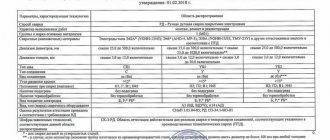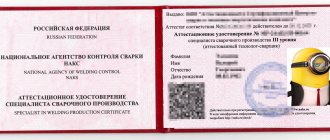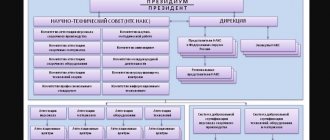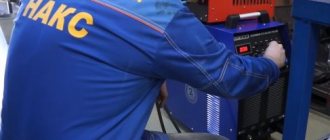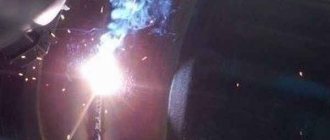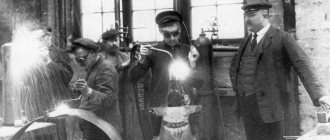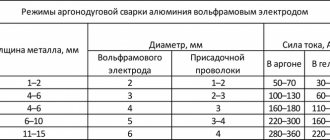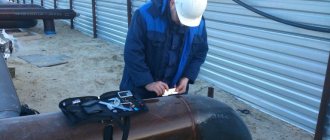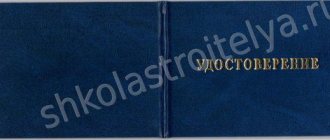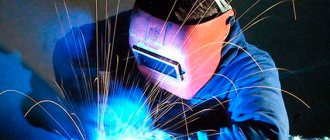Home Training and certification Personnel certification Certification in the field of NAKS
offers its assistance in training and certification of welders and welding production specialists at NAKS.
The presence of NAKS certificates for welding production is required for welders and specialists in order to perform work at hazardous production facilities, in accordance with the requirements of Rostechnadzor.
Certification/training of welders and NAKS specialists is regulated by the following documents:
- PB 03-273-99 - “Rules for the certification of welders and welding production specialists.”
- RD 03-495-02 - “Technological regulations for certification of welders and welding production specialists.”
Welders/specialists are certified in independent certification centers that are part of the NAKS structure.
NAKS certification of welders/specialists is divided into 4 levels:
- The first level (I level)
is for welders. Certification gives the right to perform direct welding work. - The second level (II level)
is for welding production masters. Certification gives the right to control the entire welding process. - The third level (III level)
is for welding production technologists specializing in welding production. Certification gives the right to determine the technology of the welding process, develop and sign technological maps. - The fourth level (IV level)
is for welding engineers. Certification gives the right to sign and approve the documentation according to which welding work is carried out at the enterprise.
Cost of NAKS certification and training for welders and specialists:
| Certification | Price |
| Certification of level 1 welders | from 15,000 rubles |
| Certification of specialists of levels 2 and 3 | from 18,000 rubles |
The exact cost is formed on the basis of the Questionnaire and depends on the level of certification, the number of specialists and the necessary parameters of welding production.
Send us an application for certification, and our managers will calculate the cost of the services you need.
Our company offers its assistance in training and further certification of welders and welding production specialists at NAKS for levels I, II, III.
Level I.
For certification of level 1 welders, the following main parameters are taken into account:
1. Welding/surfacing method:
For metal materials
- RD (111) - Manual arc welding with coated electrodes.
- RDN (111) - Manual arc surfacing with coated electrodes.
- RAD (141) - Manual argon arc welding with a non-consumable electrode.
- RADN (141) — Manual argon arc surfacing.
- MP (135) — Mechanized welding with a consumable electrode in active gases and mixtures.
- MPN (135) - Mechanized surfacing with a consumable electrode in an environment of active gases and mixtures.
- MADP (131) - Mechanized argon arc welding with a consumable electrode.
- MADPN (131) — Mechanized argon-arc surfacing with a consumable electrode.
- MPG (136) — Mechanized welding with flux-cored wire in active gases and mixtures.
- MPGN (136) — Mechanized surfacing with flux-cored wire in active gases and mixtures.
- MPI (137) — Mechanized welding with flux-cored wire in inert gases and mixtures.
- MPIN (137) — Mechanized surfacing with flux-cored wire in inert gases and mixtures.
- MPS (114) — Mechanized welding with self-shielding flux-cored wire.
- MPSN (114) — Mechanized surfacing with self-shielding flux-cored wire.
- MLSN (114) — Mechanized surfacing with self-protecting flux-cored tape.
- MSOD (113) — Mechanized open arc welding with alloy wire.
- MF (121) — Mechanized submerged arc welding.
- MDS (781) — Mechanized arc welding of studs (rods).
- MKS (782) — Mechanized contact welding of studs (rods).
- AF (12) - Automatic submerged arc welding.
- AFPN (12) — Automatic surfacing with submerged arc wire electrode.
- AFLN (12) — Automatic surfacing with a submerged strip electrode.
- AFDS (782) - Automatic submerged arc welding of studs (rods).
- AAD (141) - Automatic argon arc welding with non-consumable electrode.
- AADN (141) — Automatic argon arc surfacing with a non-consumable electrode.
- AADP (131) — Automatic argon arc welding with a consumable electrode.
- AADPN (131) — Automatic argon arc surfacing with a consumable electrode.
- APG (135) - Automatic welding with consumable electrode in active gases and mixtures.
- APGN (135) - Automatic surfacing with a consumable electrode in active gases and mixtures.
- APPG (136) - Automatic welding with flux-cored wire in active gases and mixtures.
- APPGN (136) — Automatic surfacing with flux-cored wire in active gases and mixtures.
- API (137) - Automatic welding with flux-cored wire in inert gases and mixtures.
- APIN (137) — Automatic surfacing with flux-cored wire in inert gases and mixtures.
- APS (114) - Automatic welding with self-shielding flux-cored wire.
- APSN (114) — Automatic surfacing with self-shielding flux-cored wire.
- ALSN (114) — Automatic surfacing with self-protecting powder strip.
- P (15) — Plasma welding.
- PPN (15) - Plasma surfacing with solid wire.
- PNP (15) - Plasma powder surfacing.
- ESH (72) – Electroslag welding.
- G (3) - Gas welding.
- GN (3) - Gas surfacing.
- KTS (21) - Contact spot welding.
- KSS (25) - Resistance butt welding.
- KSO (24) - Flash butt welding.
For polymer materials
- NI - Welding with a heated tool.
- ZN - Welding with embedded heaters.
- NG - Welding with heated gas.
- E - Extrusion welding.
- T - Thermite welding - types of welds.
2. OTU group (hazardous technical devices):
PTO - Lifting and transport equipment
- Load-lifting cranes.
- Cranes - pipe layers.
- Cranes are manipulators.
- Elevators.
- Tali.
- Winches.
- Load-handling devices.
- Lifts (towers).
- Escalators.
- Ropeways, their units, mechanisms and parts.
- Chains for lifting and transport equipment.
- Construction lifts.
- Passenger conveyors.
- Metal structures for lifting and transport equipment.
KO - Boiler equipment
- Steam boilers with a steam pressure of more than 0.07 MPa and hot water boilers with a water temperature above 115°C.
- Steam and hot water pipelines with a working steam pressure of more than 0.07 MPa and a water temperature of more than 115°C.
- Vessels operating under pressure above 0.07 MPa.
- Fittings and safety devices.
- Metal structures for boiler equipment.
GO - Gas equipment
- Pipelines of internal gas supply systems.
- External gas pipelines of low, medium and high pressure. 2.1. Steel. 2.2. Made from non-metallic materials.
- Gas equipment for boilers, process lines and units.
- Gas burner devices.
- Capacitive and instantaneous water heaters.
- Apparatuses and ovens.
- Fittings made of metal materials and safety devices.
NGDO – Oil and gas production equipment
- Field and main oil product pipelines, pipelines of oil pumping stations (OPS), providing transportation of oil and oil products during construction, reconstruction and major repairs.
- Field and main oil product pipelines, pipelines of oil pumping stations (OPS), providing transportation of oil and oil products during routine repairs during operation.
- Field and main gas pipelines and condensate pipelines; pipelines for transporting commercial products, pulsed, fuel and starting gas within: integrated gas treatment plants (CGTUs), compressor stations (CS), booster compressor stations (BCS), underground gas storage stations (UGS), gas distribution stations (GDS), gas flow measurement units (UZRG) and gas reduction points (PRG).
- Pipelines within the gas treatment facility, compressor station; NPS; SPHG; DKS; GRS; UZRG; PRG, etc., with the exception of pipelines providing transport of gas, oil and petroleum products.
- Tanks for storing oil and petroleum products, gas tanks for gas storage facilities during construction and repair.
- Offshore pipelines, offshore facilities (pipelines on platforms, as well as welded bases of offshore platforms) during construction, reconstruction and repair.
- Unique objects of the oil and gas industry during construction and repair (operating parameters of the objects are not provided for by the current regulatory documentation).
- Shut-off valves during production and repair in factory conditions.
- Pipeline parts during production and repair in the factory.
- Pumps, compressors and other equipment during manufacturing and repair in factory conditions).
- Oil and gas pipelines during production and repair in factory conditions.
- Oil and gas field, drilling and oil refining equipment.
- Pipelines of automated gas filling compressor stations (CNG filling stations).
MO - Metallurgical equipment
- Blast furnace, coke and steelmaking equipment.
- Technological equipment and pipelines for ferrous and non-ferrous metallurgy.
- Technical devices for the production of ferrous and non-ferrous metals and alloys based on them.
- Machines for casting steel and non-ferrous metals.
- Pipe rolling units.
- Crimping, billet, section rolling and sheet rolling mills.
OKhNVP - Equipment for chemical, petrochemical, oil refining and fire and explosion hazardous industries
- Equipment for chemical, petrochemical, and oil refining industries operating under pressure up to 16 MPa.
- Equipment for chemical, petrochemical, and oil refining industries operating under pressure of more than 16 MPa.
- Equipment for chemical, petrochemical, and oil refining industries operating under vacuum.
- Tanks for storing explosive and fire hazardous and toxic substances.
- Isothermal storage facilities.
- Cryogenic equipment.
- Equipment for ammonia refrigeration units.
- Ovens.
- Compressor and pumping equipment.
- Centrifuges, separators.
- Tanks, containers (barrels), cylinders for explosive and fire hazardous and toxic substances.
- Waste heat boilers.
- Energy technology boilers.
- Boilers HERE.
- Pipeline fittings and safety devices.
- Process pipelines and pipeline parts.
GDO – Mining equipment
- Technical devices for mining and mineral processing industries and underground facilities (including equipment for mine installations and mine elevators).
OTOG - Equipment for the transportation of dangerous goods
- Specialized containers and packaging used for the production and transportation of dangerous goods and construction materials.
- Tanks.
- Crew part.
SK - Building structures
- Metal building structures.
- Reinforcement, reinforcing and embedded products of reinforced concrete structures.
- Metal pipelines.
- Structures and pipelines made of polymeric materials.
KSM - Steel bridge structures
- Metal structures of spans, supports and pylons of steel bridges when manufactured in a factory.
- Metal structures of spans, supports and pylons of steel bridges during assembly, welding and repair in installation conditions.
3. Groups of basic materials with which the welder works
- M01 - Carbon and low-alloy structural steels of the pearlitic class with a yield strength of up to 360 MPa;
- M02 - Low-alloy heat-resistant chrome-molybdenum and chrome-molybdenum-vanadium steels of the pearlitic class;
- M03 - Low-alloy structural steels of the pearlitic class with a yield strength of over 360 MPa;
- M04 - High-alloy (high-chromium) steels of martensitic, martensitic-ferritic and ferritic classes with chromium content from 10% to 30%;
- M05 - Martensitic alloy steels with chromium content from 4% to 10%;
- M06 – Cast iron;
- M07 - Reinforcing steels for reinforced concrete structures;
- M11 - High-alloy steels of austenitic-ferritic and austenitic classes;
- M21 - Pure aluminum and aluminum-manganese alloys;
- M22 - Non-heat-strengthening aluminum-magnesium alloys;
- M23 - Heat-strengthening aluminum alloys;
- M31 – Copper;
- M32 - Copper-zinc alloys;
- M33 - Copper-nickel alloys;
- M34 – Bronze;
- M41 - Titanium and titanium alloys;
- M51 - Nickel and nickel alloys;
- M61 - Polyethylene (PE);
- M62 - Cross-linked polyethylene (PE-X);
- M63 - Polyvinyl chloride (PVC);
- M64 - Polypropylene (PP).
Levels II and III.
To certify specialists of levels 1 and 2, the following main parameters are taken into account:
- OTU groups (hazardous technical devices).
Certification of welders and NAKS specialists can be carried out in any region of the Russian Federation, regardless of where the specialist plans to work.
Certificates of welders and welding production specialists give the right to perform only those welding works for which he is certified.
Information about the documents received based on the results of certification of welders/specialists is entered into the open register of NAKS.
Validity period of documents for welders and NAKS specialists:
- 2 years – for level 1 welders;
- 3 years – for level 2 craftsmen and level 3 technologists;
- 5 years – for level 4 engineers.
Upon expiration of the certificate, it is extended; the welder/specialist undergoes periodic certification. You can submit documents for extension no later than 1 month. before the end of their term. Periodic certification can be completed no more than twice. Next, you must again undergo primary certification.
About NAKS certification
NAKS is an acronym that stands for National Welding Inspection Agency. It is part of the welding production certification system. The organization and the technology itself are subject to control. Additionally, checks are carried out regarding materials, equipment and other things.
In many industries, the welding profession continues to be the main one. Persons working in this specialty must perform a whole list of different types of work. That is why there is a need for certification, since representatives of the authorized body want to know that the company will provide quality services. NAKS performs the following actions:
- develops methodological documents;
- controls the resolution of issues arising in the above area of activity;
- monitors the work of certification centers;
- constitutes an expert commission that will conduct certification;
- is engaged in maintaining a register in which information about the certification performed and the results obtained is entered.
Only persons who have received the appropriate rank have the right to take part in the procedure. It is assigned after a person has completed specialized training and passed the relevant exams.
Carrying out the procedure
First of all, you will need to prepare documents. The list will need to include:
- application requesting access to certification;
- medical certificate demonstrating the absence of contraindications;
- documents on the education received;
- extract from the work book;
- protocols confirming the completion of safety inspections.
If certification is carried out by NAKS in Zheleznodorozhny, you will have to pass a practical and theoretical exam. Initially, attention is paid to practice. If the employee does not pass it, the test ends there. Control is carried out on the basis of current GOSTs and documents developed by NAKS.
If you pass the practice successfully, you will have to pass the theory. It depends on the level for which the person is applying. You must answer at least 15 questions. If you need to get levels 2-4, the number of questions increases to 20. Usually the test is taken electronically using computers. However, sometimes the procedure is carried out in simple written form. The theoretical part is considered passed if the person gives correct answers to at least 80% of the questions. If the test fails, a retake is acceptable. However, it is completed within 3 months.
It is recommended that you complete training before taking the exam. You can order it from us. It is permissible to master the material remotely. The specialist will not have to stop working. For training, it is enough to have access to the Internet and a device that allows you to familiarize yourself with the information. We are ready to adjust the training schedule to suit your needs. The work is carried out under a contract.
Free consultation with specialists
You will receive help and advice on any issue that arises
Send a request
